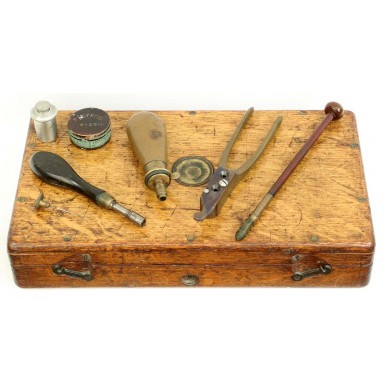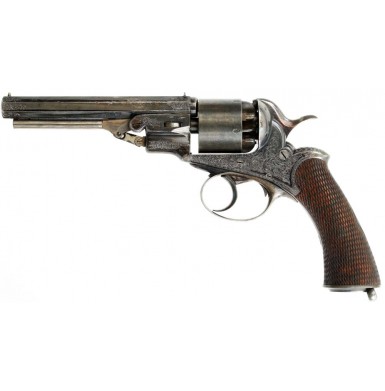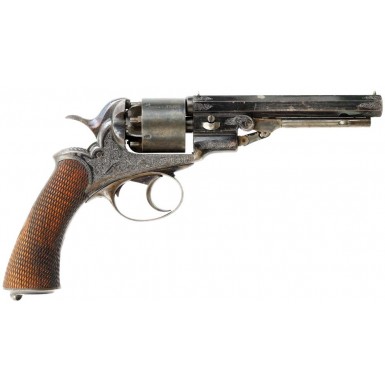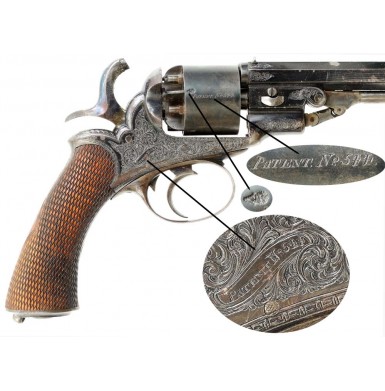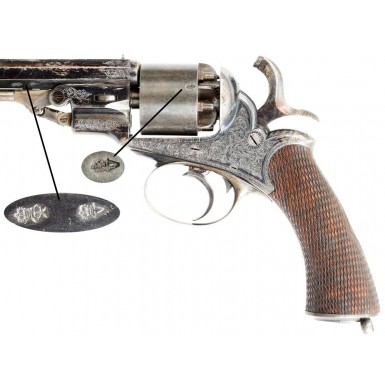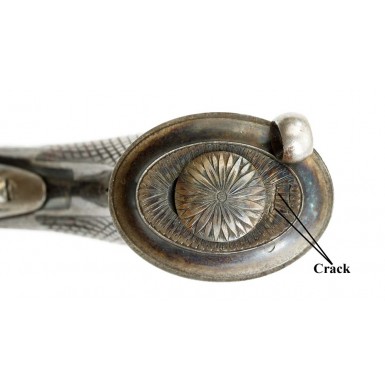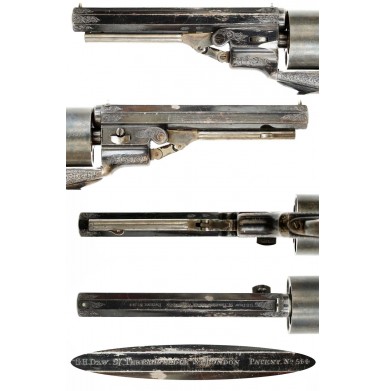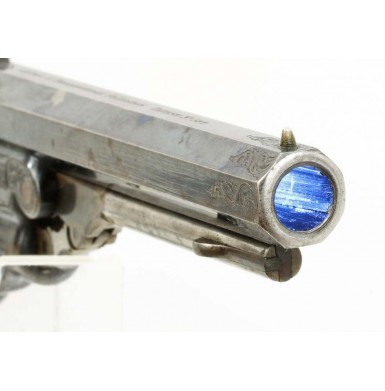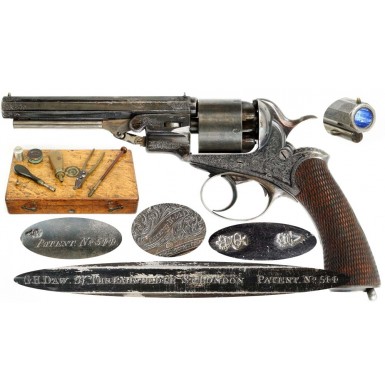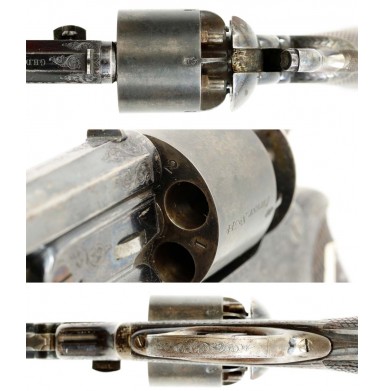Cased & Engraved Pryse & Cashmore Revolver - Very Fine
- Product Code: FHG-1872-SOLD
- Availability: Out Of Stock
-
$1.00
In 1855 Birmingham gunmaker Charles Pryse and West Bromwich (Staffordshire) gunmaker Paul Cashmore received British Patent 2018/1855 for a self-cocking revolver mechanism and various improvements to revolver designs as well as improvements to loading levers for revolvers. This patent would become the basis for what collectors refer to as the Daw revolver, a gun that is typically attributed to George H. Daw of London, but was never actually manufactured by him. The Pryse & Cashmore design was for an open top percussion revolver with a somewhat unique double-action lock work. Like a traditional “self-cocking” revolver could be cocked and fired with a single long pull of the trigger. Likewise, the revolver could also be cocked manually and then fired by pulling the trigger in a conventional single action mode. Usually, these two methods of operation taken together are considered a traditional double action revolver. The lock work, however, had an additional feature in that pulling the trigger slowly, about halfway to the rear of its full travel, allowed the hammer to engage a notch that left the revolver in a half-cocked position and the cylinder partially indexed. This allowed the cylinder to be rotated manually for loading, but also allowed a shooter to take deliberate aim, and then finish the firing sequence by finishing the trigger pull, which indexed and locked the cylinder, fully cocked the hammer and then released it to fire. This half cock position along the trigger pull pathway reduced the weight and length of the double action pull and gave the revolver the speed advantage of a double action (or self-cocking) revolver as well as the improved accuracy of a single action type trigger pull. This action was in some ways similar to the “hesitating action” used in early Adams and Tranter revolvers. The revolvers were percussion ignition with cylinders that rotated in a counter-clockwise direction. There were three major components to the revolvers: the frame, the cylinder and the barrel, which also included the loading lever assembly. The barrel was secured to the frame via a transverse wedge that entered from the right side of the gun (Colt’s entered from the left side) and passed through both sides of the barrel web and the cylinder arbor pin. An interesting feature of the design was the “U” shaped notch on the lower face of the hammer nose that was designed to rest upon safety pins on the rear face of the cylinder, between the chambers. This allowed the revolver to be safely carried with a fully loaded cylinder, with the hammer down on a safety pin. This was similar to the safety pin system found on Colt revolvers of the period, but was somewhat more elegantly executed, making the system more secure and reliable. Like most English revolvers of the era, the Pryse & Cashmore revolver was available in a variety of frame sizes and calibers. The standard models were “Holster” in 38 bore (about .50 caliber), “Army” in 54 bore (.443”), “Navy” in 80 bore (.387”) and “Pocket” in 120 bore (.338”) and it is even reported that a diminutive 240 bore (about .28 caliber) pocket model was produced as well. Barrel lengths varied with caliber with the longest barrels being utilized on the larger calibers. 38 bore revolver barrels were typically about 6 ““ in length, although examples over 8” long are known. The standard “Army” barrel was 6 “, the standard “Navy” barrel was 5 ““ as was the standard “Pocket” barrel. Of course variations could and did occur, with special order barrel lengths and calibers available. The largest calibers were only available with a 5-shot cylinder, while the 120 bore guns had a 6 shot cylinder. One variant of the 80 bore revolver was available with a solid frame, rather than an open top, and this gun was available with a 6-shot cylinder as well. A variety of loading lever systems are encountered on the Pryse & Cashmore revolvers, including those patented as part of the original revolver design, as well as a design patented by Thomas Blissett. It is believed that about 5,500 of the Pryse & Cashmore patented percussion revolvers were produced circa 1855 to 1865, with the large majority of them being retailer marked by George Daw. A handful of early examples are known with other retailer marks, but Daw was certainly involved with the marketing of the large majority of the guns. To that end he engaged in a relentless campaign to get the revolver design into the public spot light by arranging reviews and commentary in such publications as The Times and the 1860 edition of Hans Busk’s book The Rifle and How to Use It. In another period book, The Book of Field Sports author Henry Miles noted of the Pryse & Cashmore revolver: “its form is of the handsomest, its finish exquisite and it is one of the pleasantest in the hand of the many varieties of revolver we have examined.” In a further attempt to garner press and praise, Daw presented one of his rifles and a Pryse & Cashmore revolver to Italian revolutionary leader General Garibaldi in April of 1864, with an accompanying story about the engraved presentation pieces being published in the April 22nd , 1864 edition of Daily Telegraph. Despite his tireless promotional efforts and the fact that nearly all examples of these revolvers are retailer marked by Daw, it appears that all revolvers were actually manufactured by Pryse and/or Cashmore. Charles Pryse had established himself as a gunmaker on St. Mary’s Row in Birmingham in 1838 and became Charles Pryse & Company in 1840. In 1842 the firm of Pryse & Redman was formed, located at 84 Aston Road, and would remain in business through 1871. During the Civil War era, Pryse & Redman would manufacture a substantial number of P-1853 Enfield rifle muskets, many of which would go to fill contracts for the Confederacy and likely the Union as well. The firm of Charles Pryse & Co would reappear in 1874 and would remain in business through 1883. In 1886 the firm would reorganize as Thomas & Lewis Pryse (his sons) and remain in business in one form or another through 1904. Paul Cashmore established himself as a gunmaker in Churchfield, West Bromwich, Staffordshire in 1849 and moved to the Newton Street Works, Old Church in 1854. He would remain there until 1878 and would last be listed in period directories in 1883. As there is never any indication that Pryse and Cashmore ever operated out of the same premises (or even in the same town) it is unclear if only one, or both of them were producing the Pryse and Cashmore patent revolvers. However, all of the noted authors on the subject (particularly A.W.F. Taylerson) note that Daw was not the manufacturer of the guns. It appears the guns were manufactured by Pryse and/or Cashmore and delivered to Daw “in the white” for “finishing and stocking”, allowing the level of embellishment and finish to be customized to the market. Daw would also case the revolvers and provide accessories, as required. Taylerson notes that period advertisements for the Daw retailed Pryse & Cashmore revolvers listed: “Army, Navy & Pocket sizes in Holster case, extra nipples, Bullet Mould & c. from “6.10.00. Ditto in oak case and apparatus complete “7.10.00. Ditto highly finished “10.10.00. Revolving Rifles from “15.00.00.” Although the makers and retailer had hope to receive military contracts from the British government for their revolver, this never happened. The reasons were likely two fold and interrelated. The guns were not manufactured on the basis of interchangeable parts, and were mostly hand fit and assembled. This meant it would be difficult to repair them in the field and that a substantial amount of skilled labor was involved in their manufacture. The labor costs were reflected in the prices charged for the revolver, making them less enticing to a parsimonious War Department. This same set of circumstances are directly responsible for the War Department’s lack of interest in Philip Webley’s “Long Spur” revolver design from the same period. The retail price of a Colt Navy revolver during the same period in English was only “5.10.00 (uncased but with mold) and Joseph Brazier was offering Adams’ patent pistols for between from “4.10.00 and from “5.10.00. In both cases a much more robust military pattern revolver was available to compete with the Pryse & Cashmore offering for less money. As such, Daw concentrated on offering the revolvers that usually bore his name to the commercial market. George H. Daw first went into the firearms manufacturing and retailing business in 1851 as a partner in Witton, Daw & Company, located at 82 Old Broad Street in London. John Sergeant Witton had established himself as a London gunmaker in 1835 and had worked under his own name until this partnership was established. In 1853 the firm moved to a new location at 57 Threadneedle Street, and in 1854 was renamed Witton & Daw, dropping the “& Co”. In 1860 George Daw took over the firm, changing the name to George Henry Daw (or simply G.H. Daw) and operating under that name 1880, when it was changed to G.H. Daw & Co. The firm remained in business in a number of locations through at least 1889, and may have remained active as late as 1892, but it is not clear if this “Daw Gun Company” had originated with original Daw business. Daw is probably most famous, although rarely remembered for, the introduction of modern “Boxer Primed” centerfire ammunition to Great Britain in 1861. Daw acquired the British patent rights to the French patent of Francois Schneider, whose design had been further improved by Clement Pottet. Unfortunately, the French patentees did not keep their patent rights in force in France, thus removing any protection that Daw had acquired by buying their rights for patent in England. He was sued by Eley Brothers, the largest ammunition manufacturer in England, and it was found that since the French rights no longer protected the patentees, they had no rights to sell to Daw, leaving him with no protection in England. Although Daw lost his case (and his investment in the patent rights), he was still directly responsible for bringing easily reloadable, modern center fire ammunition to England. Daw’s greatest financial successes in the gunmaking business would come in the post-percussion era, with his manufacture of high quality cartridge revolvers, rifles and shotguns.
Offered here is a VERY FINE to NEAR EXCELLENT example of a Pryse & Cashmore Revolver, fully cased and factory engraved. The gun was retailed by George H. Daw after the dissolution of the Witton & Daw partnership, as the barrel address reads only G.H. DAW . 57 . THREADNEEDLE ST . LONDON PATENT. No 544. This barrel mark suggests the revolver was made circa 1860-1861 after Witton had left the firm. The low serial number, 544, suggest the revolver is a fairly early production example and that not many were produced during the years 1855-1860. The serial number 544 appears on the right side of the frame, where it is engraved PATENT No 544, on the top of the barrel flat (as noted above) and on the cylinder, which is engraved PATENT No 544 as on the frame. The lower left angled flat of the octagonal barrel is marked forward of the barrel web with the commercial London proof and view marks of a (Crown) / GP and (Crown) / V. Alternating (Crown) / V and (Crown) / GP London proof house marks are also found between the chambers of the cylinder. The presence of the London proof marks on the revolver suggest that although the guns may have been manufactured and delivered in an unfinished state to Daw by Pryse and Cashmore, he was still responsible for the proving of the guns. If the guns had been proved by the makers, they would have been marked with Birmingham commercial proof marks, rather than those of the London proof house. Early production Pryse & Cashmore revolvers show the greatest variation from the norm in terms of calibers and barrel lengths and this revolver is no exception. The revolver is chambered for an uncommon caliber for one of these revolvers, 90 bore (.372”), and has an atypical barrel length of 5”. The bore measures .372” at the muzzle and slightly larger at the forcing cone. The chambers measure between .373” and .379”, an indication of the hand finishing that has resulted in slightly imperfect chamber mouth diameters. Later production examples tend to have round rather than octagonal barrels, and as previously noted would be more standardized in caliber at 80 bore with 5 ““ barrels. The action of the revolver functions flawlessly, and the pistol times, indexes and locks exactly as it should. The original loading lever is present and functions smoothly also. The lever is a good example of one of the types patented by Pryse & Cashmore as part of their 2018/1855 patent. The lever housing incorporates an internal spring that makes the lever snap back towards the barrel, preventing the lever from dropping down and potentially locking up the revolver during use. While the spring does not provide enough tension to force the lever into the locking mechanism, it does prevent the plunger from entering the cylinder, so even if the locking latch were to break there would be no way the lever could accidently bind up the action of the revolver. The gun retains about 75%+ of its original blued finish overall. The barrel retains about 85% of its original bright blue but shows some minor wear and finish loss along the sharp edges and points of contact, as well as some minor flaking. The frame retains about 80%+ of its original blued finish with most of the loss being due to fading and flaking along the lower portion of the rights side of the frame. The areas of the frame and barrel where the finish has flaked have a nice, smooth, grayish-brown patina, with flecks of blue remaining. The cylinder retains about 30% of its original blue as well, but most of this blue has faded and dulled and only traces of bright blue remain, with mostly a dusky plum-brown and gray patina remaining. The hammer retains about 70%+ of its original brilliant fire blued coloring, but has dulled and faded somewhat, and has a smoky gray undertone with the coloring being somewhat duller and less vivid than when it was new. The trigger is similarly finished and retains strong fire blue on the upper portion where it pivots and on the rear surface, but has faded, dulled and worn on the face and sides. The triggerguard has flaked quite a bit and has lost the majority of its original blued finish. The buttcap, loading lever hinge & plunger and backstrap are all case hardened and all retain large amount of original case coloring. All of these parts show at least 80% original, vivid case colors with some dulling and thinning. The lever part of the loading lever appear to have been finished in the white with only the hinge and plunger case colored. All of the markings and engraving on the pistol remain extremely sharp and crisp, as do the edges of the barrel and the frame. Like many English revolvers of the era, this one has a lanyard ring in the butt cap. As noted in the advertisement noted above, this example is one of the “highly finished “10.10.00” revolvers, as it is factory engraved and is a truly delightful example of the British gun maker’s art in the early 1860s. The frame is decorated with delicate and expertly executed foliate scrolls that cover about 80% of its surface. Unlike most foliate scrolls of the period these are extremely tight and not the usual loose and open scrolls more commonly encountered. The muzzle and forcing cone of the barrel are engraved en-suite, with coverage that only extends for about 5/8” in either direction. The bottom of the triggerguard and backstrap are engraved in a similar manner, and the butt cap is engraved with a geometric floral motif. The buttcap incorporates a hinged storage compartment for percussion caps or spare cones (nipples). This is a common feature on English revolvers of this period. Unfortunately, the cap has broken from the hinge and has become completely detached from the buttcap hinge mechanism. The cap is currently held in place with a couple of small dots of plain white glue on the interior rim, which provide only enough tension to keep the cover in place during light handling. Any real pressure will easily separate the cover from the buttcap. I considered having a gunsmith fix this minor break, but was concerned that any heating needed to weld the cap back to the hinge would adversely affect the case coloring on the parts and chose not to do so. The new owner can decide how to proceed and whether to repair it or not. As it is, the crack is almost invisible and unless you need to use the compartment or want to display the revolver with the cover open, I see no need to risk ruining the finish to reattach the cover. The original German silver cone front sight is present on the top of the barrel, near the muzzle, and remains full height with the original crowning at its end. The original fixed notch rear sight is present at the rear of the barrel, just forward of the cylinder. The bore of the pistol is in about VERY FINE to NEAR EXCELLENT condition as well and remains extremely bright and sharp. The bore retains very crisp, narrow 5-groove rifling, and shows only the most minor traces of lightly scattered pinpricking and some light pitting; mostly in the grooves. The one-piece checkered walnut grip is in about EXCELLENT condition as well. It retains extremely sharp checkering over most of its surface, with only the most minor indication of handling and light use. The grip is free of breaks, cracks, chips or repairs, and have a rich chocolate brown color. A lovely German silver lozenge shaped escutcheon is set into the rear of the backstrap for the engraving of a monogram, but is remains blank. The grips is nicely checkered to leave a blank, un-checkered diamond pattern around the escutcheon.
The pistol is contained within its original English oak casing and is complete with all a full complement of original and period accessories. The case is trimmed with a pair of brass “bible” hinges and a round brass escutcheon plate on the top for a monogram. A brass escutcheon originally protected the lock on the front of the case, but it is now missing, as is the key for the lock. The case has a pair of brass closing clasps more often associated with Tranter style casings, than those from other makers and retailers. The case is in about VERY GOOD to NEAR FINE condition and shows some light to moderate wear and finish loss, along with a number of minor dings and mars. The interior compartments are lined with a lightly faded green baize that shows good age and wear. The lining appears to be original to the casing. The case is in solid condition with no serious weakness to the structure itself or the interior compartment dividers. The soft wood bottom of the casing does show some minor grain cracking and wear, which is typical. A small paper retailers label is affixed inside the lid, measuring about 3” wide by 1 “. The label is printed on varnished card stock and appears to be of the period. The label reads in a combination of period fonts of different sizes:
George H Daw
(Formerly Witton & Daw)
Patentee & Manufacturer of
IMPROVED FIRE ARMS,
57 . Threadneedle . St.
London
Bowles & Sons London ESTABD 1780
The paper label remains in FINE condition with some age staining and light foxing present, mostly around the edges. The “Bowles & Son’s” line refers to the London printer who produced the label for Daw. The case is filled with the expected “Daw” revolver accessories, all of which are contained in compartments. Included in the casing are the following original and related accouterments:
1) 90 bore Bullet Mould, in EXCELLENT condition. The mold is the typical 2-cavity brass mold found in many English casings, but casts two Adams style round nosed bullets with a single narrow grease groove and full caliber heel. The bullet cavities measure approximately .372” in diameter at the base and cast a bullet about ““ in length. The mold is marked No 90 on the sprue cutter, indicating 90 bore. The brass body has a rich ocher patina that is untouched and uncleaned, and the mold cavities remain bright and clean with excellent edges. The blued sprue cutter is in wonderful condition, functions smoothly and retains about 80%+ of its original vibrant fire blue, which is fading and starting to turn a plum-brown color.
2) Powder Flask in about FINE overall condition. The small bag shaped flask is of copper with an adjustable brass spout and top. The body of the flask retains traces of its original protective varnish and shows only a few small bumps and dings. The polished brass top is clearly marked in two lines DIXON & SONS / SHEFFIELD. The original fire blued closure spring is in place on the top of the flask and the flask functions correctly. The adjustable spout allows the flask to throw charges of 5/16, 4/16 or 3/16 Drams of powder, and is so marked.
3) Cap Tin in FINE condition. This original jappaned tin is empty, but retains much of its original finish. The lid is clearly embossed with ELEY BROS in an arc over LONDON This tin is more than likely a replacement and although of the period is not original to the casing.
4) Pewter Oiler in EXCELLENT condition. The oiler is complete with the detail oiler attached to the inside of the lid. The oiler is marked in a two-line cartouche on its bottom: C&JW. / HAWKSLEY.
5) A period mahogany cleaning rod with a walnut cap and removable brass jag that reveals a ball screw to pull loaded charges from the cylinder. The rod is in FINE and complete condition. The jag is correctly sized for the revolver’s bore, but may or may not be original to the casing.
6) An original cone wrench in FINE condition. The steel wrench has an ebony handle whose end has a brass cap that when unscrewed reveals a cone pick. The wrench is correctly sized for the cones of the revolver cylinder.
Overall this is a really an outstanding example of a fairly early production Factory Engraved Pryse & Cashmore “Daw” Revolver complete with original casing and accessories. The pistol is almost in EXCELLENT condition and is really quite stunning in person, when the fine quality of the engraving can be appreciated. While these revolvers can be found for sale from time to time in England, they are extremely scarce in America. Cased Pryse & Cashmore revolvers are even more rare, and completely cased, factory engraved examples are confined to a handful of extant examples that rarely appear on the market for sale. This is surely an investment-grade example that would be almost impossible to upgrade from. The gun is absolutely 100% complete and correct in every way and is in perfect mechanical condition. This will be a stunning addition to your collection of English percussion revolvers and is a gun that I know you will be very proud to own.
SOLDTags: Cased, Engraved, Pryse, Cashmore, Revolver, Very, Fine



